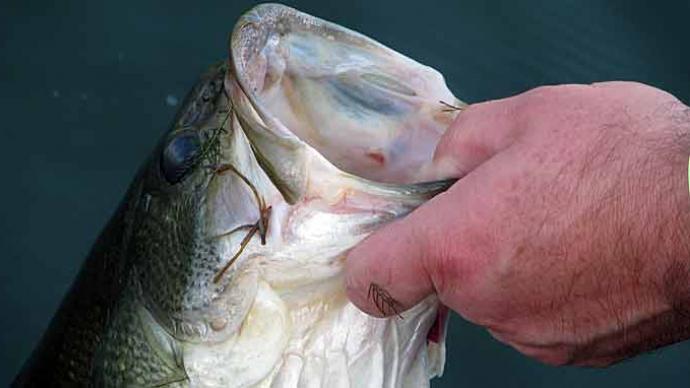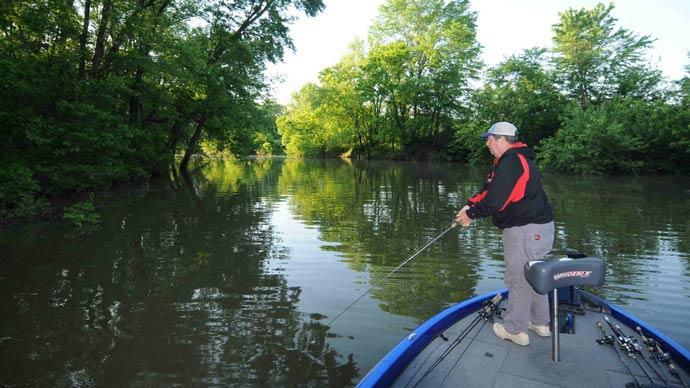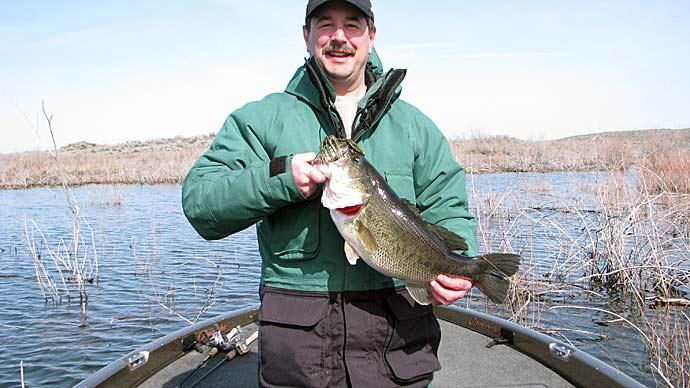
A Missouri landowner with a new pond recently phoned me here at the fish hatchery asking about prices on Florida bass fingerlings. During the conversation, it became clear his vision extends far beyond a plastic bag full of little wiggly creatures no more than two inches long.
Like so many pond owners, this guy is looking into the future. Some day, he wants to set the hook and see his rod bend double. He wants to feel the power of a huge bass heading for Canada, muscling its way toward deeper, safer water.
The landowner wants to feel his heart race, while doing battle with one of nature's top freshwater predator fish. This pondmeister wants to grow giant bass, and he wants to know if his fish have the genetic makeup to fulfill his vision.
Another pond owner in central Iowa calls Pond Boss World Headquarters, asking for information on the genetics of trout he's about to stock from private hatcheries. He's worried that trout won't survive the winter ice cap on his shallow pond.
This trout enthusiast has a personal goal for his stocking project, and he has a budget. He just wants to spend money wisely. If Farmer Jones can buy eight-inch trout, grow them to a pound and a half in six or seven months, he wants to play. If that's not possible, he needs to start with larger fish. Bigger fish cost more, and he gets a lower head count.
Do genetics play a role in these decisions? Should the amateur pond manager even be concerned with his fish genetics?
They can be quite important, says long-time fisheries biologist Barry Smith. He and his partner Don Keller run American Sportfish Hatchery near Montgomery, AL. After years of serving pond owners in the Southeast, they long ago saw benefits from infusing a population of largemouth with Florida bass genes.
"One of the most obvious (incentives) is size potential," Smith said. "There's plenty of published scientific literature, especially in south and southeast states, that prove Florida strains of bass play huge roles in potential for growth.
"If you are a trophy bass person, the likelihood of growing bass over 10 pounds is low, unless you consider genetics. Your fish need the influence of Florida genes."
Studies show that, even in ideal conditions of a well-managed system full of forage, native largemouth seldom grow larger than 22 to 24 inches and weigh more than eight pounds. But Florida bass may not be the absolute end-all answer for pond owners in the Upper Midwest, or for ponds where catching numbers of fish is more important than catching an occasional giant.
Research papers published in Alabama and Texas point out that Florida bass genetics play a key role in catchability, Smith says. Fisheries scientists call it, "angling vulnerability."
For years, biologists have known Florida bass grow larger, live longer, but tend to be more wary and less tolerant of boat traffic and other human presence, which makes them tougher to catch with rod and reel on artificial baits.
In test ponds at Heart O' the Hills Research Station near Kerrville, Texas Parks and Wildlife staff found they could catch native bass repeatedly on a certain lure. Meanwhile, pure-strain Florida-bass in an adjacent pond quickly would begin to ignore the same lure, making them significantly harder to catch than their native (or northern) cousins.
So, if a bass with Florida genes seldom eats and becomes lure-shy, how does it ever reach 10 pounds? Smith has an answer, or at least a theory based on 20-plus years of field work.
"Florida bass behave differently than natives," Smith said. "Each spring, we bring up our brood fish from earthen holding ponds, keeping the genetic strains separate, and put them into large concrete holding tanks, until we pair and stock them for spawning. While the fish are confined in the concrete tanks, we add forage fish to each vat."
The difference in behavior becomes readily apparent.
"The native fish go nuts, eating forage fish so fast they gorge themselves," Smith said. "The natives do that until their stomachs can hold no more, or until the forage fish are gone"
Florida-strain bass, Smith says, tend to be more cautious, feeding only when hungry.
"All things being equal," he said, "forage fish in a holding tank of Floridas will last at least three days."
Pass the Grey Poupon.
"Aggressiveness of native bass is inheritable," Smith said. "Introduce a native northern fish, he will be easier to catch, and so will his offspring."
Years ago, this caused Smith and Keller, and other fisheries consultants, to re-evaluate their stocking strategies for ponds. Today, most consultants try to balance size with catchability. Thinking pond owners arrive at these decisions after considering management goals they have set for their ponds.
Do you want your guests to catch lots of fish? Or do you want the challenge and potential for frustration that goes with trying to land a lunker? Smith tries for the best of both worlds.
"Now we recommend a cross between pure strain Floridas with native stocks, the Fl hybrid," Smith said. "The native stocks we have selected have been culled for aggressiveness for more than 10 years.
Other consultants and hatcheries also recommend mixing gene pools. From my own field experience in southern Oklahoma and Arkansas, climate can be a problem. Florida bass don't like cold water, and I have found that to be true as far south as northern Texas, in the Panhandle and just north of the Red River.
Each pond is different, of course, with variations in water clarity, depth, food sources, water quality and bottom features. For clients in this general geographic region, we at Texoma Hatchery recommend that clients use a mix of native northern bass with Floridas. In time, that gives us the Fl hybrid, with the characteristics we like.
If your pond lies much north of the 35th parallel it may be wise to hedge your genetic bet. But even above a line from, say, Fresno to Albuquerque to Tulsa to Chattanooga to Charlotte, there's hope for the Florida bass, at least in some limited applications.
"Stay local," says Mark Harbin of Harbin Fish & Bait Farm of Harper, KS. "Stock fish that have already adjusted to your climate.
"Work with local fisheries biologists to learn where to find those stocks. Don't expect Florida bass raised in Texas to do well if they're stocked in Nebraska ponds. They won't. Find fish native to your region."
Genetics play a significant role for pondmeisters interested in rapid growth, larger fish, and catchability. Fish hatcheries look at genetics for different reasons than huge sizes and catchability. Catfish and trout farms continually select fish for consistent growth rates and resistance to disease. Different markets, different production needs.
Since fish farms grow fish at far high population densities than recreational ponds, diseases can become an issue. When over-crowded, catfish are subjected to conditions such as channel catfish virus disease and a variety of parasites and bacteria. In trout, whirling disease is always of concern.
To minimize expensive medications and quarantines, commercial fish farms give more than a cursory look to genetic selectivity. Departments of Natural Resources and Game and Fish Commissions around the country keep a watchful eye on genetic works of public and private hatcheries, to protect and defend the nation's stocks of "native" fishes, especially waterways with trout. That's where questions on private trout production find answers.
When it comes to managing a pond for trout and other gamefish, Chuck Gruentzelm, 77, aquatic biologist from Gillett, WI, draws on decades of practical experience.
"I have raised different varieties of trout in the past, and I understand our DNR is working with hybrid strains," pond environment plays a more significant role for trout than genetics, so I wonder about the necessity of genetic selection of trout for recreational ponds."
Trout do not naturally hybridize, Gruentzelm says, so people tend to use fish produced from commercial hatcheries.
"I have had more problems dealing with genetics of sunfish than trout," Gruentzelm said, making pointed reference to the genetic alteration using female green sunfish crossed with male bluegill.
His point: One of the attractions of hybrid fish is that they are thought to grow large and to be sterile, so the pond owner has full control over population dynamics. When it comes to hybrid sunfish, this is false on both counts. Fact is, other sunfish species grow larger than the green sunfish, and many species of hybrids reproduce.
In Michigan waters, where Dave Ouawinga of Stoney Creek in Grant, MI is based, the kamloop rainbow trout has caused a stir.
"For our region, that's a faster growing genetic strain, but the kamloop is pretty much the extent of genetic selection we use," Ouawinga said. "The kamloop's feed conversion rate is good, and growth rates are good. There are a few strains of German brown trout, that were considerably slower growing. We stopped using those, and focused on kamloop trout."
So does it make sense for you to dive into the genetic pool? That depends on your management goals. In the case of Florida bass genes, they may be a huge plus for some pond owners, a hindrance for others.
As for the pond owner in Missouri, if he stocks Florida bass in the Show Me State, it's something of an experiment. The proof, as they say, will be in the pond.
The author, a 20 year veteran fisheries biologist, is working on his third book, "Desiging and Building Your Own Pond." He may be reached at Texoma Hatchery (903) 564-5372.
Reprinted with permission from Pond Boss Magazine



